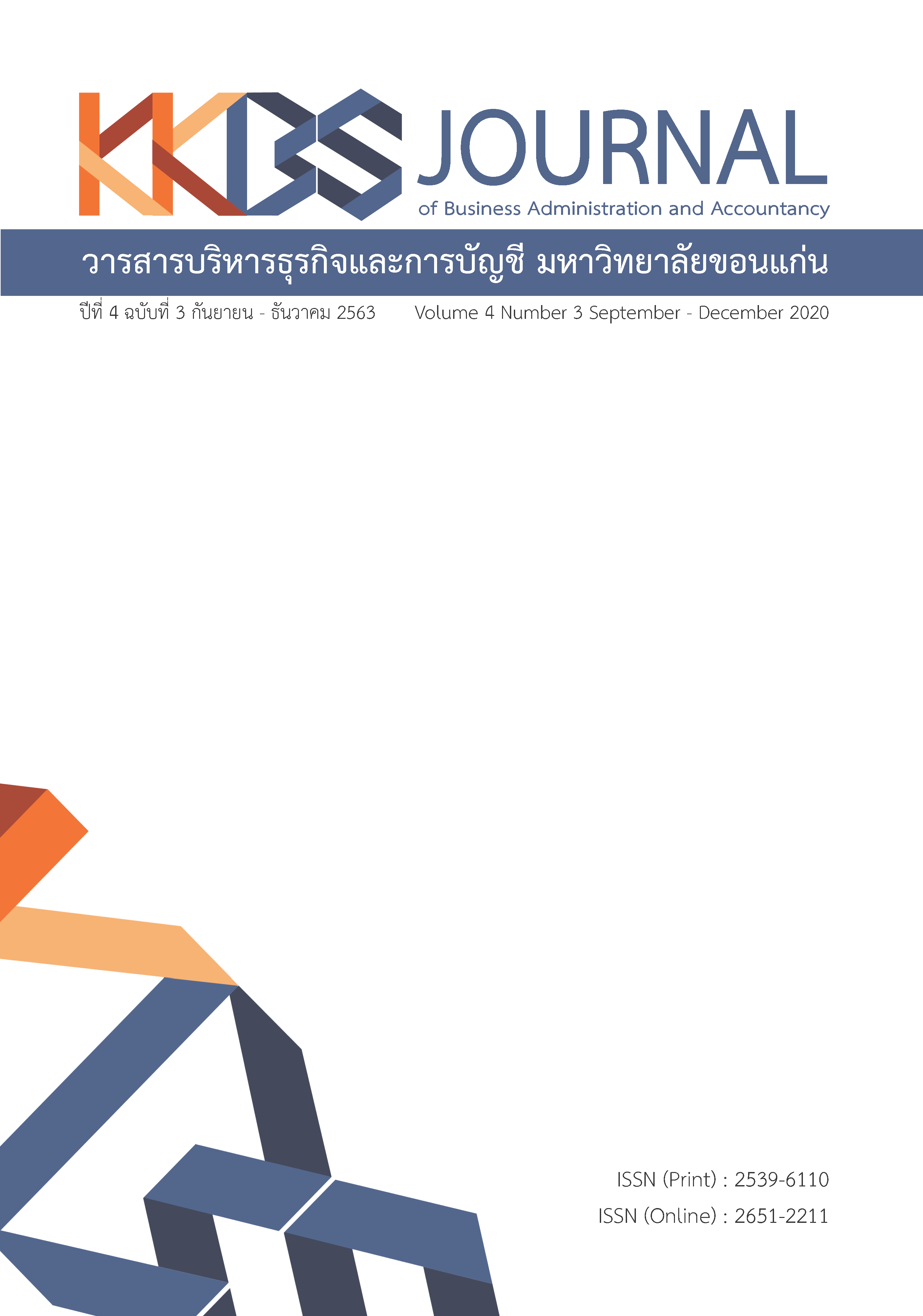การตรวจสอบปัจจัยที่ส่งผลต่อความพึงพอใจของนักท่องเที่ยวชาวต่างชาติที่เดินทางท่องเที่ยวชายหาดในจังหวัดภูเก็ต
Main Article Content
บทคัดย่อ
การศึกษาครั้งนี้ตรวจสอบความพึงพอใจต่อประสบการณ์โดยรวมของการเดินทางท่องเที่ยวชายหาดจังหวัดภูเก็ต โดยใช้แบบสอบถามในการสำรวจความพึงพอใจและประสบการณ์จากนักท่องเที่ยวชาวต่างชาติจำนวน 400 คน ณ บริเวณชายหาดในจังหวัดภูเก็ต ซึ่งใช้เทคนิคการุสุ่มกลุ่มตัวอย่างตามสะดวกในการเก็บข้อมูล ผลการศึกษาที่วิเคราะห์ด้วยการถดถอยเชิงพหุพบว่า ความพึงพอใจต่อคุณลักษณะของชายหาด และความพึงพอใจต่อความปลอดภัยมีอิทธิพลต่อความพึงพอใจโดยรวมของนักท่องเที่ยว นอกจากนั้นความพึงพอใจต่อคุณลักษณะของทะเลไม่มีอิทธิพลอย่างมีนัยสำคัญต่อความพึงพอใจโดยรวมของนักท่องเที่ยวชาวต่างชาติ ซึ่งข้อเสนอแนะสำหรับการศึกษาครั้งต่อไปและข้อเสนอแนะต่อการนำผลการศึกษาไปปฏิบัติได้นำเสนอไว้ในบทความอีกด้วย
Article Details
บทความที่ได้รับการตีพิมพ์ในวารสารเป็นความคิดเห็นของผู้เขียน มิใช่ความคิดเห็นของกองบรรณาธิการและคณะผู้จัดทำวารสาร และบทความที่ได้รับการตีพิมพ์เป็นลิขสิทธิ์ของวารสารบริหารธุรกิจและการบัญชี มหาวิทยาลัยขอนแก่น
เอกสารอ้างอิง
Alves, B., Benavente, J. & Ferreira, Ó. (2014). Beach users' profile, perceptions and willingness to pay for beach management in Cadiz (SW Spain). Journal of Coastal Research, 70(sp1), 521-526.
Ariza et al. (2012). On the relationship between quality, users’ perception and economic valuation in NW Mediterranean beaches. Ocean & Coastal Management, 63, 55-66.
Ariza et al. (2010). Proposal for an integral quality index for urban and urbanized beaches. Environmental Management, 45(5), 998-1013.
Botero et al. (2014). Recreational parameters as an assessment tool for beach quality. Journal of Coastal Research, 70(sp1), 556-562.
Botero et al. (2013). Reasons for beach choice: European and Caribbean perspectives. Journal of Coastal Research, 65(sp1), 880-885.
Buchner, A., Erdfelder, E. & Faul, F. (1997). How to use G* Power. Retrieved fromhttp://www.psycho.uniduesseldorf.de/aap/projects/gpower/how_to_use_ gpower.html.
Bujosa, A., Riera, A. & Pons, P.J. (2015). Sun-and-beach tourism and the importance of intra-destination movements in mature destinations. Tourism Geographies, 17(5), 780-794.
Cong, L.C. (2016). A formative model of the relationship between destination quality, tourist satisfaction and intentional loyalty: an empirical test in Vietnam. Journal of Hospitality and Tourism Management, 26, 50-62.
Dodds, R. & Holmes, M.R. (2019). Beach tourists; what factors satisfy them and drive them to return. Ocean & Coastal Management, 168, 158-166.
Dodds, R. (2010). Determining the economic impact of beaches: Lake Huron Shoreline from Sarnia to Tobermory. Toronto: Ryerson University and Ausable Bayfield Conservation Authority.
Esichaikul, R., Chansawang, R. & Choksuvanich, W. (2018). Problems and obstacles of developing cruise home port in Andaman tourism cluster. University of the Thai Chamber of Commerce Journal (Humanities and Social Sciences), 38(4), 81-106. (In Thai)
Frampton, A.P. (2010). A review of amenity beach management. Journal of Coastal Research, 26(6), 1112-1122.
Griffiths et al. (2019). An assessment of areal and transect-based historic shoreline changes in the context of coastal planning. Journal of Coastal Conservation, 23(2), 315-330.
Hosany et al. (2017). Mediating effects of place attachment and satisfaction on the relationship between tourists’ emotions and intention to recommend. Journal of Travel Research, 56(8), 1079-1093.
House, C., Samways, J. & Williams, A. (2015). Designing coastal management strategies for populations with distinct needs: the case of learning disabilities. Coastal Management, 43(6), 589-608.
Houston, J.R. (2008). The economic value of beaches: a 2008 update. Shore and Beach, 76(3), 22-26.
Kim, J.O. & Mueller, C.W. (1978). Factor analysis: statistical methods and practical issues. London: Sage.
Klein, L. & Dodds, R. (2017). Perceived effectiveness of Blue Flag certification as an environmental management tool along Ontario's Great Lakes beaches. Ocean & Coastal Management, 141, 107-117.
Klein, L. & Dodds, R. (2018). Blue Flag beach certification: an environmental management tool or tourism promotional tool? Tourism Recreation Research, 43(1), 39-51.
Laughery, K.R. & Wogalter, M.S. (2014). A three-stage model summarizes product warning and environmental sign research. Safety Science, 61, 3-10.
Loomis, J. & Santiago, L. (2013). Economic valuation of beach quality improvements: Comparing incremental attribute values estimated from two stated preference valuation methods. Coastal Management, 41(1), 75-86.
Lucrezi, S. & Saayman, M. (2015). Beachgoers' demands vs. Blue flag aims in South Africa. Journal of Coastal Research, 31(6), 1478-1488.
Lucrezi, S. & van der Walt, M.F. (2016). Beachgoers’ perceptions of sandy beach conditions: demographic and attitudinal influences, and the implications for beach ecosystem management. Journal of Coastal Conservation, 20(1), 81-96.
Lucrezi, S., Saayman, M. & Van der Merwe, P. (2016). An assessment tool for sandy beaches: A case study for integrating beach description, human dimension, and economic factors to identify priority management issues. Ocean & Coastal management, 121, 1-22.
Matthews, B., Andronaco, R. & Adams, A. (2014). Warning signs at beaches: Do they work? Safety Science, 62, 312-318.
McKenna, J., Williams, A.T. & Cooper, J.A.G. (2011). Blue Flag or Red Herring: Do beach awards encourage the public to visit beaches? Tourism Management, 32(3), 576-588.
Micallef, A., Williams, A.T. & Gallego Fernandez, J.B. (2011). Bathing area quality and landscape evaluation on the Mediterranean coast of Andalucia, Spain. Journal of Coastal Research, 61(61), 87-95.
Office of the Board of Directors of the National Tourism Policy. (2017). The plan of national tourism development issue 2 (2017 – 2021). Bangkok: The War Veterans Organization of Thailand. (In Thai)
Office of the Committee of Andaman Tourism Cluster. (2016). Andaman tourism cluster plan. Phuket: Office of the Committee of Andaman Tourism Cluster. (In Thai)
Prebensen, N., Skallerud, K. & Chen, J.S. (2010). Tourist motivation with sun and sand destinations: satisfaction and the worm-effect. Journal of Travel & Tourism Marketing, 27(8), 858-873.
Rutty, M. & Scott, D. (2010). Will the Mediterranean become “too hot” for tourism? A reassessment. Tourism and Hospitality Planning & Development, 7(3), 267-281.
Siwapiroonthep, N. (2014). Tourists’ satisfaction and recommendation on visiting Cha-am Coast, Phetchaburi Province. Journal of Cultural Approach, 15(27), 28-38. (In Thai)
Songsuk, S. (2014). Factors affecting Thai tourists’ satisfactions towards the tourist source management Phi Phi Don Island and Phi Phi Lay Island, Krabi Province. SSRU Graduate Studies Journal, 2(2), 113-122. (In Thai)
Triantafillidou, A. & Petala, Z. (2016). The role of sea-based adventure experiences in tourists’ satisfaction and behavioral intentions. Journal of Travel & Tourism Marketing, 33(sup1), 67-87.
Tuntipisitkul, P. (2016). Problems about beach safety issues for visitors: The case of Phuket Island. Journal of Thai Hospitality & Tourism, 11(1), 27-37. (In Thai)


